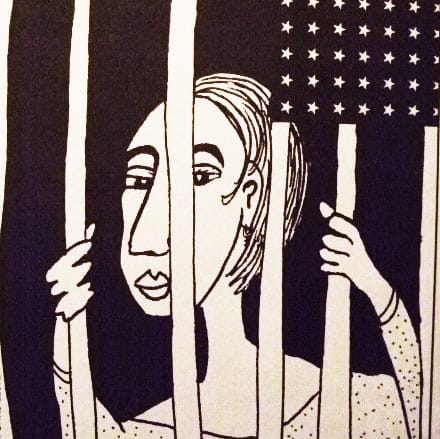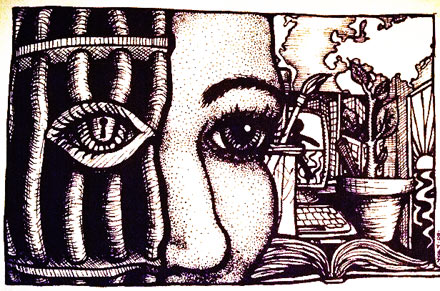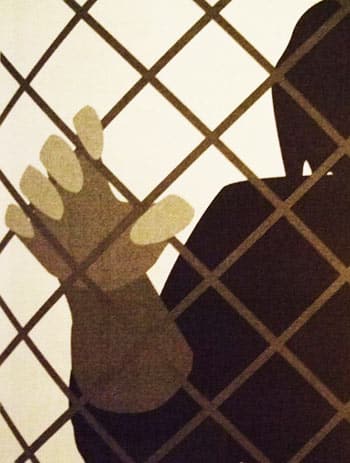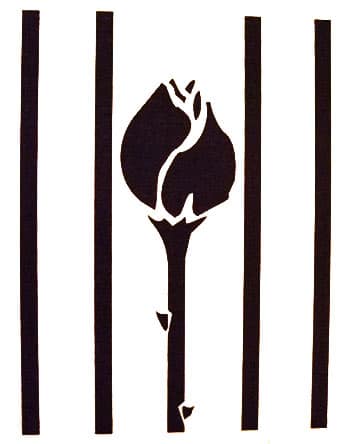by Rhonda Copelon
When one compares what is done to a woman in an advanced domestic battering cycle and to prisoners subjected to torture, the situations are frighteningly similar. But only recently have they begun to be equated legally and culturally.
How would the world be different for women if domestic violence were treated as torture or as cruel, inhuman or degrading treatment?
In 1958 on the Tenth Anniversary of the Universal Declaration of Human Rights, Eleanor Roosevelt said: “Where, after all, do universal human rights begin? In small places, close to home — so close and so small that they cannot be seen on any map of the world. Yet they are the world of the individual person: the neighborhood he lives in; the school or college he attends; the factory, farm or office where he works. Such are the places where every man, woman, and child seeks equal justice, equal opportunity, equal dignity without discrimination.“
Groundbreaking as this was, it wasn’t yet time to envision human rights in the home or to understand domestic violence as a form of torture. This has been the task of 20th century women’s movements.
Dangers In the Home
The tenacious worldwide epidemic of “gender violence” gained traction as a human rights issue for two reasons. First, domestic anti-violence movements transformed what had been considered “private” into “public.” Second, survivors of wartime and dictatorial atrocities and activists in the global human rights movement of the early 1990s forced recognition of gender violence as a violation of human rights, not only where officials of the state perpetuated the violence, but also where officials were complicit in letting it happen. Intimate violence, like other forms of gender violence, is viewed today as a violation of international human rights, including the right to life, liberty and security of person.

The next step in this legal and cultural revolution is to treat gender violence as torture. So far, rape—in war, by the state and where the state does not take measures against it–has been acknowledged in international law as an act of torture. Domestic violence—the most private and most common of all forms of gender violence—is on its way.
Taking this step asserts that domestic violence ranks with the gravest human rights violations and that violence in intimate relationships is no less heinous and damaging than violence in official prisons and interrogation “booths.” The tortures authorized by U.S. officials against male detainees in Guantanamo and Abu Ghraib, including methods of sexualized humiliation and fear-induction, bear strong resemblance to what is tolerated as “domestic” violence.
Torture is defined internationally as involving a severe infliction of physical or mental suffering, which is intentional and not accidental, and is done not only to extract information, but also for such purposes as punishment, coercion, intimidation or discrimination of any kind. Under legal standards, torture requires that a state official inflict or instigate the violence, or consent or acquiesce to the suffering. According to this standard, if a state official knows or has reason to believe that private violence is threatened or ongoing, the state must exercise “due diligence” by attempting to prevent it, protect and compensate the victim, and prosecute the perpetrator. Overarching is the responsibility to take whatever measures are reasonable and necessary to prevent torture, especially where it is systemic.
While women are not the only victims of domestic violence, we are overwhelmingly so. Because of its disproportionate effect on women, domestic violence is also viewed as a brutal form of discrimination against women. It is notable that, despite the international recognition of gender violence as a grave violation of human rights principles, U.S. constitutional law does not accept domestic violence as either a civil or human rights violation.
Refusing to Tolerate Gender Violence
I was first inspired to think about intimate violence as torture by a workshop on gender violence and human rights at the 1991 Latin American and Caribbean Feminist Meeting (Encuentro Feminista). There, several Madres of the Plaza de Mayo in Argentina and women who opposed official torture insisted that what happens to women in violent homes was equivalent to the violence of dictatorial prisons. Despite the skepticism of some leading mainstream human rights scholars, I studied this question and was stunned by the parallels and the light they shine on the connection between personal, societal and militaristic violence. This is developed in my article Intimate Terror: Understanding Domestic Violence as Torture, in a law review and a book on women’s human rights edited by Rebecca Cook. I wanted to help people think about what happens in the private sphere in a new light, hoping that would contribute to taking the onus of blame off the battered woman and placing it squarely where it belonged — on both the perpetrator and on the passive state.
Over the last decade and a half, this perspective has made slow, but sure, progress in the international arena through the efforts of many women. In the last year, the UN Committee Against Torture, which monitors and interprets the Convention Against Torture and Other Cruel, Inhuman or Degrading Treatment or Punishment and the UN Special Rapporteur on Torture –critical international authorities–have both recognized that domestic violence can be torture where it meets the international definition discussed below. These developments add to previous statements by the UN Human Rights Committee and the Special Rapporteurs on Violence Against Women. This progress is due to the work of feminist experts in and outside the UN and the demands of the global women’s human rights movement.

Torture is not limited to water boarding, as the current U.S. debate makes it seem; nor does it require any special equipment. The most common physical methods of both torture and domestic violence are beating, burning, tying up, choking, threatened asphyxiation (the goal of water-boarding), pulling out nails, stripping naked, mutilating, inflicting rape and other sexual assault, and threatening to kill or attack the victim’s children. Psychological torture includes subjecting the victim through threats and intermittent violence to persistent fear, sleep deprivation, humiliation and insult, particularly of a sexualized character. Torture involves cycles of oppression and release, and good cop/bad cop roles designed to fool people into trust. Battering, too, involves intermittent periods of wooing the victim, weeping and seeking forgiveness.
The pain and suffering inflicted is likewise severe. Battering too frequently results in femicide and, by comparison to official torture, women die in much greater numbers as result of intimate assaults, as described in the In-depth Study on All Forms of Violence Against Women by the UN Secretary General. Recent statistics from New York indicate that intimate violence is still the first cause of homicide against women.
Like prisoners, battered women suffer the pain and terror of attack, as well as the physical consequences of bruises, broken bones, mutilation, organ failure, disability and, in some cases, infertility. Psychologically, post-traumatic stress disorder (PTSD) can be devastating and affects victims of torture, sexual violence and battering. Official torture may instill fear that one has said something that will reveal and harm another and often shatters one sense of security in the world. Domestic violence may be equally or more shattering psychologically. Judith Herman wrote in her classic 1997 study of trauma and recovery, that unlike the victim of official torture, battered women do not see the batterer as their enemy, and thus they must also unlearn love, trust and reliance.
Battering is intentional in the same way that torture is. It is not an accident that a partner, usually a woman, is targeted for battering. Battering, like torture, is a controlled and usually a very deliberate, patterned process. Torturers may feel authorized or required to harm, while batterers effectively decide to lose control in the intimate context (they didn’t beat up the co-worker or the boss). Both believe that violence is justified to achieve their aims in response to the resistance of the prisoner or the failures or “disobedience” of the battered woman or partner. There is also the dynamic of threat: torturers identify the prisoner as a threat to safety or something they believe in; likewise batterers’ often fragile identity as master is threatened by the merest assertion of independence.
The purposes of battering are co-extensive with those of torture. The battered woman or partner is usually isolated; jealousy reigns and the smallest error or independent action is cause for violence. Thus, the domestic interrogation: what did you do? where were you when I called? why is this dirt on the floor? But the recognized purposes of torture are broad. It’s not the information, but the submission of the victim that is at its core. Battering is often a form of punishment for petty or imagined “infractions” or “disobedience”—the coffee is cold; you’re ugly; you’re unfaithful.
Coercion, intimidation and humiliation– tools of subordination–are the common purposes of both torture and battering. And gender violence is, by definition, discriminatory.
Official Action in Inaction
For domestic violence to be considered a human rights violation under international legal standards, the “state” must be involved in some way. International law recognizes state complicity through consent or acquiescence, for example, the failure to respond to a call for help, to institute and monitor the effectiveness of measures to prevent violence, the failure to prosecute perpetrators and to provide protection and reparations to victims.

In the domestic violence situation, there are no official walls or guards around the battered woman, as there are in official detention situations. Some argue that the lack of detention prevents domestic violence from being considered torture.
Some abused women, especially immigrant domestic workers, may be physically locked in. But lock-in is not required. For battered partners, liberty or leaving may be impossible. A common tactic of batterers is to isolate the victim by forbidding contact with others and constant monitoring and surveillance—for example through frequent calls or surprise visits. Although domestic violence manifests itself in many different individual situations, the battered woman or partner is often confined by fear, as well as dependency. The lack of access to effective justice or protective alternatives can leave her without recourse. While some women are reduced to learned helplessness, or suffer from the Stockholm syndrome in which an abused person identifies with her abuser, many more make decisions within a limited frame of possibility.
According to law professor Martha Mahoney for others, many women’s lives are most at risk when they try to escape since batterers may pursue their prey. For all these reason, leaving may not be an option. Consequently, understanding domestic violence as torture needn’t depend upon the presence of bars or walls.
To insist on a requirement of official detention as an element of torture ignores the positive responsibility of the state under international human rights law. When the state, having notice of the problem, fails to attempt to prevent the violence or to intervene, it is consenting or acquiescing to this violence. Celina Romany described in the 1993 Harvard Human Rights Journal (Vol. 87) the battered woman as living in a “parallel state,” in which the batterer reigns supreme and the official state, by virtue of its non-action, is complicit.
Take, for example, the tragic case in Castle Rock, Colorado of Jessica Gonzales whose three daughters were abducted contrary to a judicial order of protection and murdered by her husband. Ms. Gonzales repeatedly notified the police of the abduction and the mandatory protective order, but they dismissed her concern and refused to respond to the apparent danger. The U.S. Supreme Court ruled that she had no federal civil rights claim because the state had no responsibility to protect her from private violence under the U.S. Constitution. Ms. Gonzales’ claim is now pending before the Inter-American Commission on Human Rights.
This represents an extreme failure of the state to exercise due diligence. Many actions signal a violation by the state of its duty to prevent torture and protect its victims — if a battered woman or partner cannot access protection because the police don’t respond or because she can’t make herself understood, or she is subjected to ridicule, or the police side with her husband; if there is a failure to provide shelter or prosecute; or if the state provides no remedy for these failures.
Likewise, the state perpetuates violence and torture when the state takes away the victim’s children, arrests her on the perpetrator’s say-so or when the judicial machinery is so riddled with sexism or racism that domestic violence victims are reluctant to use it. The result is to discourage recourse to the state, notes Natalie Sokoloff.
The international system has clearly recognized rape and some forms of sexualized violence by the state and in war and conflict as torture. In the past few years, various law-making bodies in the UN system have also declared that domestic violence can constitute torture. Two human rights treaty bodies (to which the U.S. is subject)—the Human Rights Committee and the Committee Against Torture–have equated domestic violence with torture or cruel, inhuman or degrading treatment. Other UN Special Rapporteurs who advance international law through analysis and interpretation have also identified the gendered dimensions of torture.
Why the Designation of Torture Matters
How could the recognition of domestic violence as torture make a difference?
Feminists understand the power of naming — naming can trivialize or clarify. Calling severe domestic violence “torture” or “cruel, inhuman or degrading treatment” inscribes the gravity of domestic violence and emphasizes the urgency of response.
It signals to battered women or partners that this violence is not their fault or shame, but someone else’s very serious criminal act. It asks people to think differently about what we have euphemistically called “domestic violence,” with the hope that growing condemnation of this badge and incident of patriarchy will lead to more thoroughgoing efforts to transform the patriarchal, militaristic culture that perpetuates this violence.
This naming also carries with it more immediate, practical consequences.
It demands broad and urgent action by governments. It requires that criminal sanctions be available, although it is not my purpose to argue for enhanced or mandatory penalties where they are not appropriate. If prevention is the dominant goal, we will need to correct the systemic discrimination that causes many women, particularly those from poor and minority communities, to fear state intervention. To this end, alternatives to law enforcement are needed to honor victims’ wishes and respond to their needs.
In the U.S., a torture framework for intimate violence would require federal involvement to ensure stricter standards and closer monitoring of the local authorities. At the least, it calls for recognition of federal civil rights remedies so that the pleas of a Jessica Gonzales are not dismissed. It makes it a federal responsibility to ensure that protection be afforded through shelters, financial assistance and social support to battered women. It also demands that state judicial systems be cleansed of the sexism and racism that impedes access to justice.
And since programs to reform batterers rarely have an effect, this approach requires, in my view, fierce educational efforts from early childhood on. The focus should be on replacing the tolerance of intimate violence with gender equality, respect and anger management. Programs must address the underlying discrimination that casts women — economically, socially and psychologically — in inferior positions, contributing to their vulnerability to relationship violence.

For immigrant women, this framework supports the granting of asylum to ensure that women won’t be sent back to places where they are likely to be subjected to domestic violence. It will also aid those domestic workers, often immigrants, who are trapped in situations of abuse. The torture framework will apply to other forms of private abuse that are tolerated by the state, whether incest or elder abuse in homes, or violence that occurs in schools, hospitals, senior facilities and other institutions.
Realizing the Promise of Human Rights for Women
Stopping torture in intimate relationships is key to breaking the socio-cultural cycle of violence that grips generations. Simply recognizing domestic violence as torture will not solve the problem of domestic violence. But, combined with feminist advocacy against gender violence and the growing human rights movement in the U.S., it will help make domestic violence a front burner issue, hastening both the impartiality, adequacy and appropriateness of official responses and the cultural revolution that demands absolute and unconditional condemnation of such violence.
The Universal Declaration, which recently celebrated its 60th anniversary, recognized the rights of “everyone,” prohibited sex discrimination, and charged the state with ensuring political and civil liberties, as well as the enjoyment of economic, social and cultural rights. Now, our job is to work explicitly to realize its promise. As Eleanor Roosevelt said: “Without concerted citizen action to uphold these rights close to (and, we must add, in the) home, we shall look in vain for progress in the larger world.”
Rhonda Copelon is a Professor of Law and Director of the International Women’s Human Rights Law Clinic (IWHR) at the City University of New York (CUNY) Law School.
Also see Start Twisting Gender Equality in Support of American Women by Janet Benshoof in this edition of On The Issues Magazine.
See Terror in Our Homes: Violence Against Women in Zimbabwe by Tawanda Mudzonga in the Cafe of the Fall 2008 edition of On The Issues Magazine.
